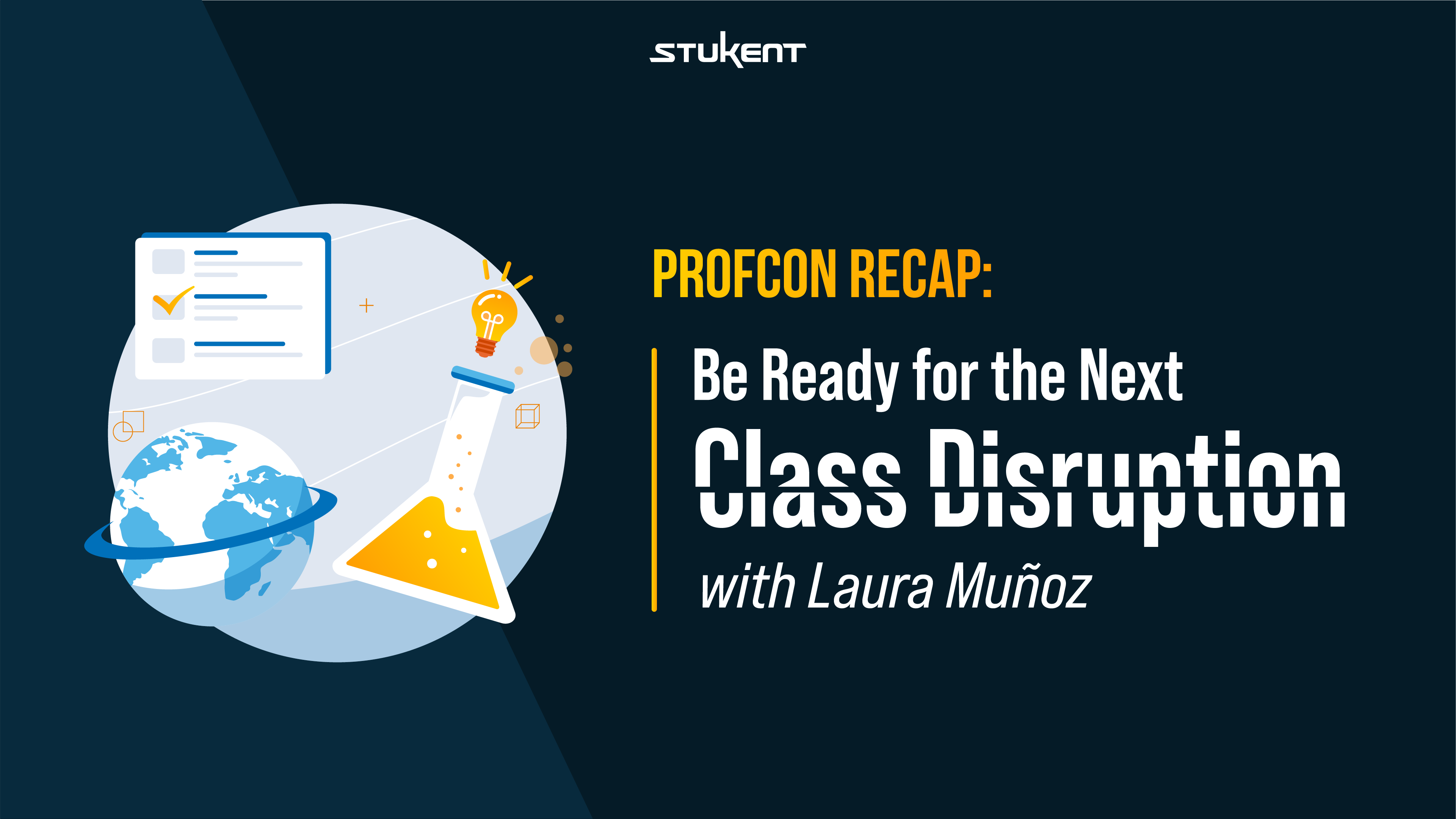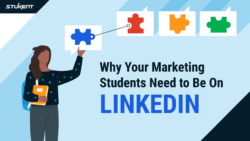When day-to-day life gets disrupted, it can be difficult to provide students with a high-quality educational experience. Whether your classroom faces a global pandemic, wildfires, hurricanes, or other disasters, you can provide students with a haven in the storm. But how do you give them consistency, communication, and a solid curriculum in the midst of chaos?
Laura Muñoz, a professor at the University of Dallas and Stukent author, joined us at ProfCon 2022 to share her favorite insights for weathering classroom disruptions. Recently, Laura researched how the SCARF model of human behavior can be applied to higher education, hoping to find ways to help her students thrive in adversity. At ProfCon, she presented actionable, powerful strategies to help your students succeed, no matter the situation.
If you missed Laura’s presentation, “Be Ready for the Next Classroom Disruption,” you can view her session on demand at the Stukent Webinars Library. Or, read on to get Laura’s insights!
Education as a Service
In essence, higher education provides a service. “A service is a series of [intangible] steps … that the consumer does not see,” Laura says. And just like any service, there can be variability and failures in the delivery of a course. Technology fails. Instructors fall ill. Accidents happen.
To help mitigate the effects of variability, Laura suggests tempering students’ expectations: “We have to manage students’ expectations. … [Ask yourself], ‘Have I allowed [students] to adapt their expectations [to the situation], and what have I done as a professor to make sure they understand that the conditions of the class have changed?’”
When disruptions affect class schedules, assignment deadlines, and exams, communicating expectations to students becomes more important than ever. According to Laura, professors are “in charge of the service recovery,” which means they need to work to rectify the situation for students.
“Amend things,” Laura says. “Restore them. Offer [students] an option. That’s why it’s so popular [to record] Zoom sessions for those who cannot attend … so they can watch it later and catch up.” The more flexibility you can offer your students during a crisis, the easier it will be for them to meet your expectations.
SCARF Model
Laura and her colleagues studied the SCARF model to find better ways to address service failure in the classroom. “SCARF” stands for Status, Certainty, Autonomy, Relatedness, and Fairness, and this model provides a framework for understanding the biological foundation of human motivation and interactions. Laura states, “Educators can use [the SCARF model] to navigate motivational factors to achieve the best performance from their students.”
- Status. When challenging times arise, “people want to feel that their status is not lost — humans want to feel like their dignity will be respected. We want to feel like we matter,” Laura says. If students feel seen, they will be more engaged in your class, no matter what might be happening around them.
- Certainty. In crises, “our brain wants to understand and forecast future outcomes,” Laura says. When things go wrong, it’s okay if professors don’t have all the information or answers up front. Reach out to students and tell them to stand by, and more importantly, tell them when they can expect to hear from you again.
- Autonomy. “Students want professors to stay in control … and maintain control of the class,” Laura says. Amid upheavals such as the COVID-19 pandemic, students may rely on their instructors to provide a semblance of normalcy.
- Relatedness. “People want to feel safe,” Laura says. “[People] want to feel like they are in this together.” During the height of the pandemic, Laura says that her students would often text her to thank her for the consistency and regularity of her classes, which made them feel less isolated during quarantine.
- Fairness. “Our students want a sense of fairness in all social interactions,” Laura says. Students want to see that everyone is getting their fair share; during a crisis, equitable treatment and access are critical to preserving morale.
How to Use the SCARF Model to Recover Educational Services
So, how can the SCARF model help you recover from service disruptions in the classroom?
Expectations
The key SCARF components for expressing expectations include status and fairness, as students want to feel valued, accepted, and respected in their “new normal.”
In terms of status, professors can adjust expectations about class attendance and deadlines for submittables. “Give students some grace,” Laura says. “Allow for a window of days” when it comes to viewing class recordings, submitting assignments, projects, and papers, or taking exams. If you give students a window to submit their assignments, it shows that you value their time and contributions.
“What matters is that the professor adapts [student] expectations toward live class attendance,” Laura says. Students want to feel as though their opinions are valued and that they are accepted in class.
As far as fairness is concerned, decisions must be transparent, reasonable, and equitable to all students in class. “Explain your decisions,” Laura says, and be sure “students receive the grade they deserve.”
Promptness
In terms of promptness, professors should consider status, certainty, and fairness to help motivate their students. “Status matters,” Laura says. “I’m not surprised this value [was reflected in every aspect of our research]. Everyone wants to be seen, respected, and treated as human beings.”
When it comes to certainty, students need “clear rules and order” to be successful. They want to know the expectations for each assignment, and instructors must provide clear and structured approaches to the material. Certainty also increases with prompt, clear communication.
Laura says she’s amazed at how few professors respond to students’ emails or messages. “[We should] respond, [and] we should do it in a prompt way,” Laura says, which means professors should strive to respond to students’ inquiries in two days or less. Or, if you can’t respond to a student’s concern immediately, let them know when they can expect an answer from you. A quick reply ensures that students understand your expectations and helps them to feel valued.
Laura also suggests that professors inform students of resources to support their physical, emotional, and mental well-being, as well as resources that may help them academically. Professors can also offer extended virtual office hours to accommodate extenuating circumstances.
Lastly, professors must remember that people process information differently when under duress. “When we are stressed, when our classes are already interrupted, people process information differently. … What’s happening may or may not compute.” Remind your students that you will continue to be fair and follow the syllabus and instructions you gave them — doing that will help restore their internal balance.
Voicing Concerns
Like the previous two points, you can bolster students’ status and certainty by allowing them to voice their concerns. Students want to be heard. “We [should] ask students about their concerns in class,” Laura says. “It doesn’t have to be formal … it can simply be an email that says, ‘Hey! I’m just making sure that everyone is doing okay.’” Zoom classes can make this especially easy, as professors can assess their students’ status by polling them in chat.
Whether you reach out in person or online, use an amicable tone. “We have to try a bit harder and be a little more expressive” when writing those emails or polls, Laura says, as it’s easy to misread the intent of an email. Furthermore, “it’s not enough to do it once,” Laura says. If you’re dealing with ongoing challenges, you must continually reassess how your students are faring.
Finally, allowing students to voice their concerns boosts feelings of relatedness, as it allows students to feel connected to a larger community or group.
The Missing Factor
According to Laura, autonomy was the only SCARF factor that didn’t appear in their research. “Students don’t want to be in control,” Laura says. “Students want certainty, they want relatedness, and they want fairness. [Students say], ‘Tell me what to do, tell me how to do it, and tell me kindly.’” Laura says she was amazed that autonomy was the last thing students wanted.
By applying the SCARF model to your classroom, you can give your students the status, certainty, relatedness, and fairness they need to weather any situation. To learn more about Laura’s work, including her groundbreaking “Introduction to Business” courseware, please visit our website.
We hope you enjoyed ProfCon 2022 as much as we did! See you in Idaho Falls in 2023!
ProfCon 2022 was a three-day academic conference held from June 15 – 17, 2022. Each year, ProfCon presents actionable tips and strategies for marketing, business, and communications educators to use in their classrooms. To watch sessions on demand, visit the Stukent Webinars Library.
To learn more about Stukent’s revolutionary courseware and simulations or get FREE instructor access to our products, visit our website.






